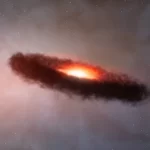Key Takeaways:
- NASA’s James Webb Space Telescope (JWST) captures a rare triple-image supernova, SN H0pe, providing a unique cosmic perspective.
- The supernova’s appearance is due to gravitational lensing, a phenomenon where gravity warps space-time, magnifying distant objects.
- SN H0pe’s triple duplication offers a potential solution to the long-standing cosmic puzzle known as the “Hubble tension.”
- The Hubble tension arises from conflicting measurements of the universe’s expansion rate, known as the Hubble constant, using different methods.
- Type 1a supernovas like SN H0pe, considered “standard candles,” offer a consistent reference point for measuring cosmic expansion.

In a remarkable cosmic revelation, NASA’s James Webb Space Telescope (JWST) has unveiled a distant supernova that appears not once, but three times within the same image. Dubbed SN H0pe, this extraordinary discovery has ignited hope among scientists that it could provide the key to resolving one of the universe’s most perplexing enigmas.
SN H0pe, a type 1a supernova, initially surfaced in images captured by the JWST in March. In these visuals, the exploding star manifests as a striking arc of orange light encircled by three luminous points. This captivating spectacle is the result of gravitational lensing, a phenomenon where the gravity of massive foreground objects warps the space-time through which light from a distant object passes. This lensing effect not only magnifies the distant object but also alters its appearance.
The three brilliant spots within the arc surrounding galaxy cluster PLCK G165.7+67.0 (G165), located some 4.5 billion light-years from Earth, may suggest the presence of three separate light sources, visually manipulated by the foreground galaxy. However, in reality, the supernova, positioned around 16 billion light-years from us, has been duplicated twice due to the gravitational lensing effect.
What makes SN H0pe particularly fascinating is its potential to tackle a long-standing cosmic conundrum known as the “Hubble tension.” This tension arises from a puzzling inconsistency in measurements of the universe’s expansion rate, as determined by the Hubble constant. While one method, which relies on cosmic microwave background (CMB) radiation, provides a certain value, another method involving the movement of specific cosmic objects, such as galaxies and supernovas, yields a slightly higher value.

This discrepancy has baffled scientists for decades, as there is no clear explanation for why these two methods should yield different results. In fact, this issue has even been considered a crisis in cosmology. However, SN H0pe, as a type 1a supernova, holds immense promise as a “standard candle,” a remarkably consistent reference point for gauging the universe’s expansion.
Type 1a supernovas have the unique characteristic of near-identical initial luminosity and gradual dimming over time. By comparing these standard candles at various distances from Earth, scientists can calculate their rate of recession and, consequently, determine the universe’s expansion rate.

What makes SN H0pe stand out is its status as the second most distant type 1a supernova ever observed. Furthermore, the gravitational lensing and the supernova’s tripartite duplication in the JWST images provide researchers with an abundance of valuable data.
The concept of using duplicated supernovae to address the Hubble tension is not entirely new. In a recent development, scientists employed data from another recurring supernova, Refsdal, which appeared four times due to lensing effects. While this approach didn’t fully reconcile the two different Hubble constant measurements, it did reduce the disparity, offering a glimmer of hope for future convergence.
While it remains uncertain whether SN H0pe can definitively resolve the Hubble tension, researchers are optimistic. If the JWST can continue to identify distant standard candles, it may hold the key to unraveling this longstanding cosmic mystery, providing deeper insights into the fundamental nature of our universe.


